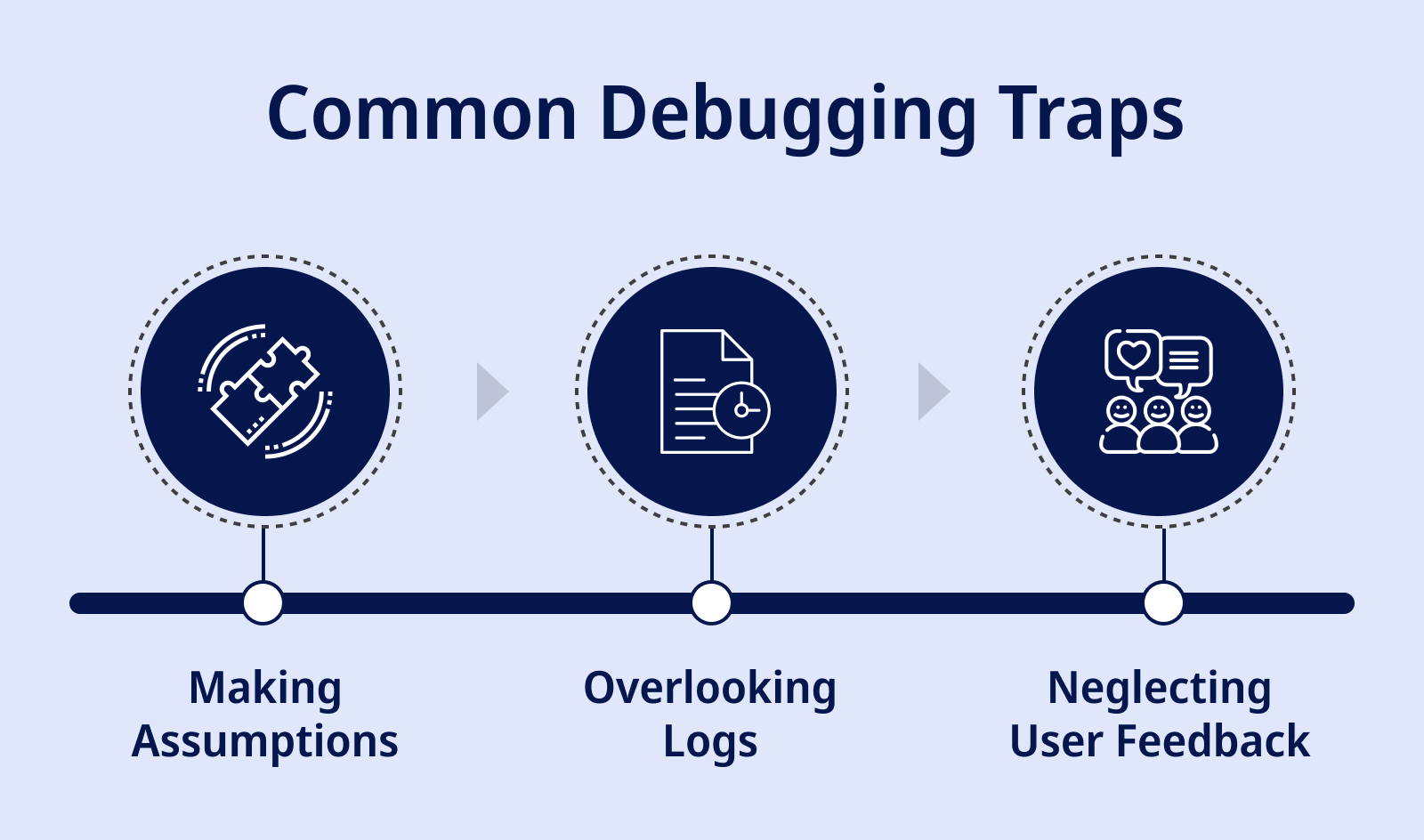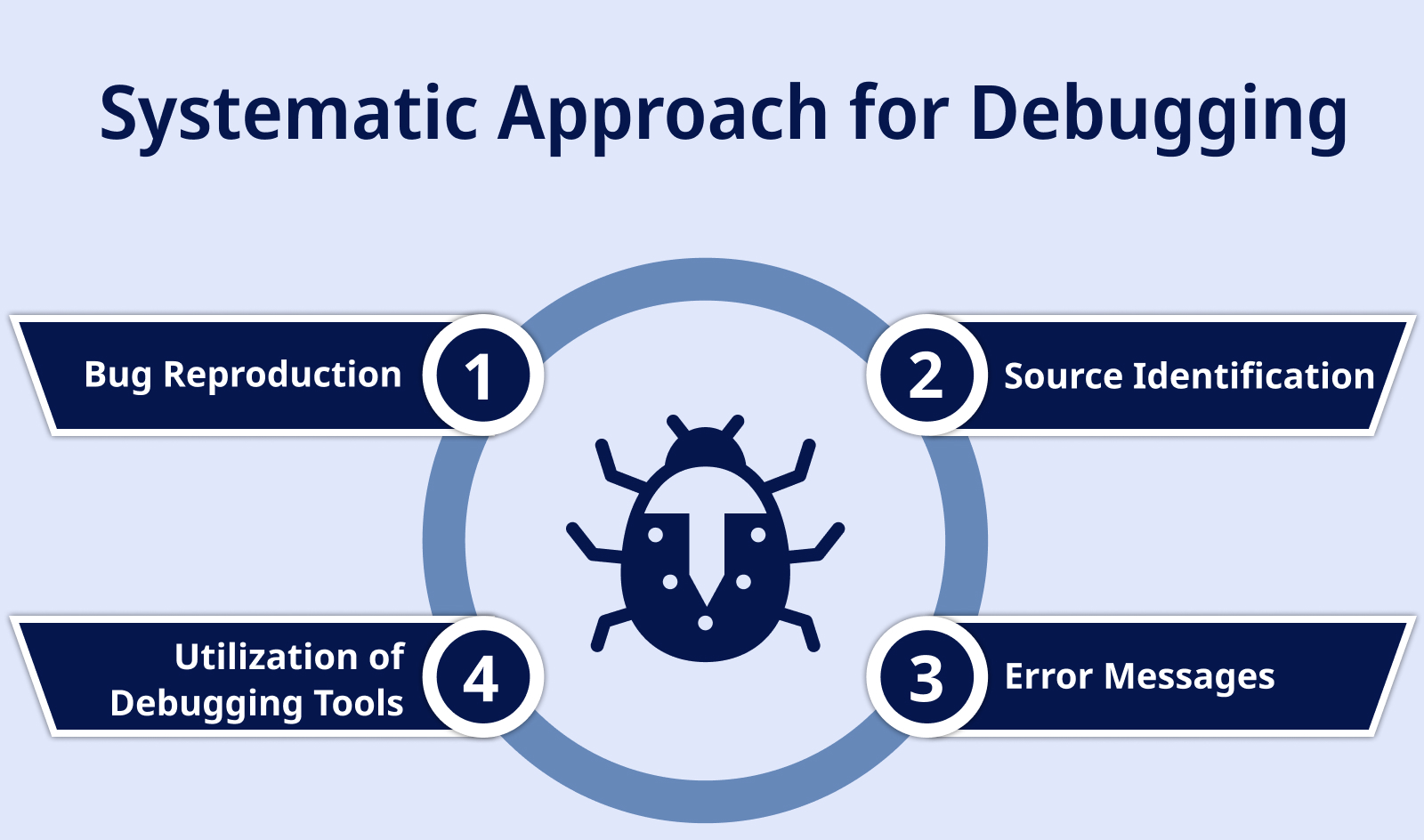Have you ever encountered those troublesome bugs that seem to pop up unexpectedly?
In the field of software development, bugs are like secret agents that can wreak havoc on your code. But fear not! Our step-by-step guide is your trusty toolkit to conquer these coding conundrums.
Imagine a world where apps run smoothly without glitches or unexpected crashes. That’s the world we aim for, and our guide will show you the way. From understanding the art of debugging in software engineering and setting up your debugging arsenal to diving into strategies that streamline the hunt for bugs, we’ve got you covered.
This post helps you to navigate common pitfalls and empowers you to embrace the challenge of debugging.
Understanding the Debugging Process
The debugging process involves identifying and rectifying errors in software code. Let’s understand the process in more detail.
Debugging is the art of identifying and resolving errors or bugs within software code. It’s an integral part of the software development process, ensuring the final product functions as intended.
These bugs can range from syntax errors and logical flaws to performance issues, and their impact can be far-reaching, affecting user experience, security, and overall functionality.
Effective debugging requires a systematic approach, patience, and a keen eye for detail. It’s not just about fixing the immediate issue; it’s about uncovering the root cause to prevent similar problems in the future.
Debugging is not limited to new code; even well-established applications can develop bugs due to updates, new features, or changes in the underlying environment.
The Impact of Bugs
Bugs in software can have serious repercussions, leading to financial losses, reputational damage, and user dissatisfaction. Consider a scenario where an e-commerce platform experiences a bug that causes incorrect pricing calculations during checkout.
Such a bug could lead to incorrect customer charges, resulting in lost sales and damaging the company’s reputation.
In safety-critical industries like healthcare and aviation, bugs in software systems can have life-threatening consequences. Even minor bugs in medical devices or flight control systems can compromise patient safety or airline operations.
It underscores the critical role that effective debugging plays in ensuring the reliability and safety of software applications.
Preparing for Effective Debugging
Effective debugging starts long before you encounter the first bug. It involves setting up the right foundations and adopting practices that streamline the process.
Code Documentation
Clear and comprehensive code documentation is the bedrock of effective debugging. When developers revisit the code, well-documented functions, variables, and modules make understanding the logic easier, reducing the time spent deciphering the code’s purpose.
Here’s how documentation contributes to better debugging:
Functionality Clarification: Documentation explains the purpose and functionality of code segments, aiding in quickly identifying where a bug might originate.
Faster Onboarding: New team members can grasp the codebase faster with proper documentation, leading to faster bug fixes and improvements.
Easier Troubleshooting: Detailed comments within the code can highlight potential areas prone to bugs, allowing developers to focus their efforts more effectively.
Version Control
Version control systems (VCS), like Git, play a crucial role in debugging by maintaining a history of code changes. Here’s why VCS is a debugging ally:
Historical Context: VCS allows you to trace back to the exact version where a bug was introduced, aiding in pinpointing its origin.
Experimentation: Branching in Git allows you to create isolated environments to test fixes without disrupting the main codebase.
Collaboration: VCS facilitates collaboration among team members, enabling simultaneous debugging without conflicts.
Step-by-Step Process to Master Debugging
Mastering debugging involves a systematic approach to identifying and resolving software issues. The approach involves the following steps:
Reproducing the Bug
Accurate debugging begins with reproducing the bug consistently. Replication provides a controlled environment for analysis and testing. Without a consistent reproduction, debugging becomes a shot in the dark, leading to unreliable fixes.
Identifying the Source
Pinpointing the root cause requires a methodical approach. Techniques like binary search and code inspection can help narrow down the problem area. Removing code sections can reveal which part triggers the bug, aiding in focused debugging.
Using Debugging Tools
Leveraging debugging tools in software testing enhances the efficiency of bug identification.
a. Xcode Debugger: For iOS/macOS developers, Xcode’s debugger offers tools to inspect variables, step through code, and visualize complex data structures.
b. LLDB: A command-line debugger, LLDB is highly customizable and offers powerful features for dynamic code analysis, making it a favorite among advanced developers.
c. Instruments: Ideal for profiling and performance debugging, Instruments provide insights into memory usage, CPU utilization, and other critical metrics.
Analyzing Error Messages
Error messages serve as clues to the bug’s nature. Developers should scrutinize:
Understand Context: Error messages often point to the line causing trouble; trace the code path leading to the error.
Error Type: Identify if it is a syntax error, runtime error, or logical error to determine the approach for resolution.
Stack Trace: Examine the stack trace to uncover the sequence of function calls and method invocations leading to the error.
Variable Values: Check the values of relevant variables to find discrepancies that might trigger the error.
External Resources: Google the error message; forums and documentation might offer solutions from developers who faced similar issues.
Strategies for Effective Debugging
Effective debugging is a skill that involves employing specific strategies to identify and resolve software issues efficiently. They are:
Divide & Conquer
Divide and conquer is a powerful debugging strategy that involves breaking down a complex issue into smaller, manageable parts. By isolating specific code sections, developers can narrow down the potential source of bugs.
The approach simplifies debugging, as each segment is easier to analyze and test independently.
Additionally, isolating smaller sections reduces the complexity of interactions between different parts of the code, making it easier to identify the root cause of the issue.
Code Reviews
Peer code reviews offer a fresh perspective and play a pivotal role in identifying bugs. A second set of eyes can catch mistakes the original developer might overlook.
Code reviews also facilitate knowledge sharing among team members, enabling insights into approaches and potential pitfalls.
Constructive feedback and suggestions for improvement further contribute to enhanced code quality and bug prevention.
Regression Testing
Regression testing is critical to ensure bug fixes do not introduce new issues. It involves retesting the entire application, focusing on areas related to the fixed bug.
This debugging process in software testing safeguards against the unintended consequences of code changes, helping developers catch any regressions that might occur due to the modifications.
By running automated regression tests, developers can confidently verify that the bug has been resolved without causing new problems elsewhere in the application.
Common Debugging Pitfalls to Avoid
Navigating the intricate terrain of debugging demands vigilance against common pitfalls that impede progress. If left unchecked, these pitfalls can prolong the debugging process and hinder effective issue resolution.
1. Making Assumptions
One of the most prevalent traps is making assumptions about the origin or cause of a bug. Relying solely on assumptions without thorough investigation can lead developers down the wrong path, wasting time on irrelevant fixes.
To avoid this pitfall, approach debugging with an open mind and let the evidence guide you toward an accurate diagnosis.
2. Overlooking Logs
Logs can be an invaluable source of data during debugging. Failing to utilize logs effectively means missing valuable insights into program execution, variable values, and error messages.
Neglecting logs can obscure the understanding of code behavior, making bug identification and resolution more challenging. Always examine logs diligently, as they often hold clues that lead directly to the root cause.
3. Neglecting User Feedback
Users can unwittingly serve as bug detectors, reporting unexpected behavior or errors. Ignoring user feedback can result in unaddressed bugs that affect user experience.
Embrace user-reported issues as opportunities for improvement and consider them seriously, as they can highlight scenarios you might not encounter during testing.
Wrapping Up
Mastering the art of debugging approaches in software engineering is not just about fixing code; it is about honing your critical thinking, attention to detail, and perseverance.
So, approach those enigmatic bugs the next time you encounter them confidently. You’ve acquired the tools and knowledge to trace their origins, decode error messages, and achieve bug-free triumphs.
Moreover, if you ever need expert guidance, remember that Vinove stands ready to assist. Our experienced team understands the intricacies of debugging and deliver tailored solutions to ensure your code remains robust and glitch-free. Happy coding and happy debugging!


